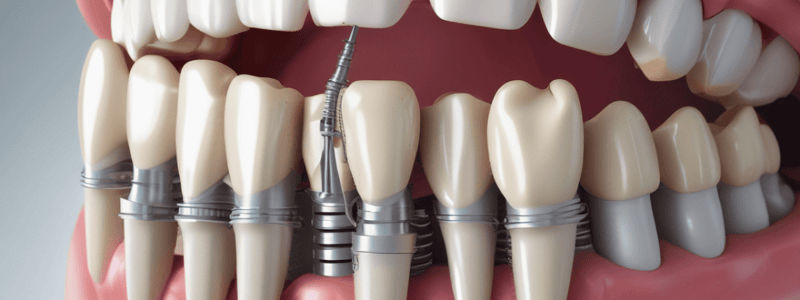Podcast
Questions and Answers
What is the primary consideration for implant placement in the maxillary anterior region?
What is the primary consideration for implant placement in the maxillary anterior region?
esthetic zone
What is the typical cervical diameter of natural teeth in the maxillary anterior region?
What is the typical cervical diameter of natural teeth in the maxillary anterior region?
6.5-10.5 mm
What happens to the thin labial bone lying over the facial aspect of a maxillary anterior root after tooth loss?
What happens to the thin labial bone lying over the facial aspect of a maxillary anterior root after tooth loss?
it remodels and the crest width shifts to the palate, decreasing 40% within the first 2 years
How is the occlusal table modified in unesthetic regions to accommodate the implant size and position?
How is the occlusal table modified in unesthetic regions to accommodate the implant size and position?
Why do maxillary posterior teeth often have reduced occlusal tables from the palatal aspect?
Why do maxillary posterior teeth often have reduced occlusal tables from the palatal aspect?
What is the primary purpose of using a barium sulfate radio opaque template in implant restoration?
What is the primary purpose of using a barium sulfate radio opaque template in implant restoration?
What is the key vertical parameter in treatment planning for implant restorations?
What is the key vertical parameter in treatment planning for implant restorations?
What is the advantage of using a fixed partial denture that is completely implant-supported over joining implants to teeth?
What is the advantage of using a fixed partial denture that is completely implant-supported over joining implants to teeth?
What is a crucial factor to consider when evaluating the suitability of an implant site?
What is a crucial factor to consider when evaluating the suitability of an implant site?
What is the primary consideration for a partially edentulous prosthesis design?
What is the primary consideration for a partially edentulous prosthesis design?
What is the significance of placing the implant in the correct facial lingual position?
What is the significance of placing the implant in the correct facial lingual position?
What is the difference in the amount and contour of metal work between an FP-1 and an FP-3 restoration?
What is the difference in the amount and contour of metal work between an FP-1 and an FP-3 restoration?
What is the consequence of natural resorption or osteoplasty at the time of implant placement on the available bone height?
What is the consequence of natural resorption or osteoplasty at the time of implant placement on the available bone height?
Why may the teeth in an FP-3 restoration appear unnatural in length?
Why may the teeth in an FP-3 restoration appear unnatural in length?
What anatomical features should be considered when designing the occlusal table in an FP-3 restoration?
What anatomical features should be considered when designing the occlusal table in an FP-3 restoration?
What is the typical position of the available bone in teeth exhibiting periodontal bone loss and gingival recession, compared to the ideal bone position of a natural root?
What is the typical position of the available bone in teeth exhibiting periodontal bone loss and gingival recession, compared to the ideal bone position of a natural root?
How is the gingival third of the crown typically positioned in an anatomical crown restoration, compared to the original tooth?
How is the gingival third of the crown typically positioned in an anatomical crown restoration, compared to the original tooth?
What percentage of patients display almost all the maxillary teeth during a smile, and how does this impact esthetic zone considerations?
What percentage of patients display almost all the maxillary teeth during a smile, and how does this impact esthetic zone considerations?
How is the low lip position evaluated during speech, and what is its significance in implant placement and restoration design?
How is the low lip position evaluated during speech, and what is its significance in implant placement and restoration design?
What is the difference in the display of anterior teeth and gingiva during speech and smiling between older and younger patients, and what implications does this have for implant placement and restoration design?
What is the difference in the display of anterior teeth and gingiva during speech and smiling between older and younger patients, and what implications does this have for implant placement and restoration design?
Flashcards are hidden until you start studying




